British Rail Class 142
The British Rail Class 142 is a class of Pacer diesel multiple-unit passenger trains used in England and Wales. 96 units were built by British Rail Engineering Limited's Derby Litchurch Lane Works between 1985 and 1987. They were a development of the earlier Class 141, which were introduced in 1984. The first batch (142001-050) was delivered in 1985, with the remaining units (142051-096) being delivered between 1986 and 1987.
| British Rail Class 142 Pacer | |
|---|---|
 Northern Rail 142066 at Castleton East Junction in June 2008 | |
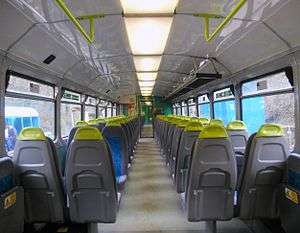 The interior of an Arriva Trains Wales Class 142 in March 2013 | |
| In service | 1985–present |
| Manufacturer | British Rail Engineering Limited, Derby Litchurch Lane Works Leyland Bus |
| Order no. |
|
| Family name | Pacer |
| Constructed | 1985 (142001 - 050) 1986-1987 (142051 - 096)[2] |
| Entered service | 1985-87 |
| Refurbished |
|
| Number built | 96 units |
| Number in service | 15 units (National Rail) |
| Number preserved | 15 units |
| Number scrapped | 36 units |
| Formation |
|
| Diagram | |
| Fleet numbers | |
| Capacity | |
| Operator(s) |
|
| Depot(s) | |
| Line(s) served |
|
| Specifications | |
| Car body construction | Steel underframe. Aluminium alloy body and roof. |
| Car length | 15.55 m (51 ft 1⁄4 in)[2] |
| Width | 2.8 m (9 ft 2 1⁄4 in)[2] |
| Height | 3.86 m (12 ft 8 in)[2] |
| Articulated sections | 2, flexible diaphragm[4] within unit only |
| Wheelbase | 9 m (29 ft 6 3⁄8 in)[4] |
| Maximum speed | 75 mph (120 km/h)[2] |
| Weight | 24.5 t (24.1 long tons; 27.0 short tons) per vehicle |
| Prime mover(s) | one per car: Cummins LTA10-R [8] (Originally fitted with Leyland TL11)[2] |
| Engine type | 6-cylinder 10-litre [8] (Originally 6-cylinder 11.1-litre)[2] turbo-Diesel |
| Power output | Cummins: 225 hp (168 kW) at 2100 rpm[8] Leyland: 205 hp (150 kW) at 1950 rpm[2] |
| Transmission | Voith T211r two-stage hydraulic[2]
(originally SCG 4-speed mechanical) |
| Train heating |
|
| Braking system(s) | Air[4] |
| Safety system(s) | AWS,[4] TPWS |
| Coupling system | BSI[9] |
| Multiple working | Classes 14x, 15x and 170[2] |
| Track gauge | 1,435 mm (4 ft 8 1⁄2 in) standard gauge |
Description
The unit's body is based on that of the original Leyland National bus; many fixtures and fittings of the bus can be found on the units.[10][11] Each unit has a seating capacity of any number between 102[5] and 121 passengers per two-car set. In theory there should be 106 or 121 seats per unit.[12] However, many units have had seats removed to provide additional space for wheelchair access. The same engines and mechanical transmissions were used as on Class 141, as also the same double-folding external doors. Each car has a fuel capacity of 125 gallons.[13]
Rail squeal
Excessive flange squeal on tight curves has been a problem on many routes operated by 142s,[14] caused by the long wheelbase and lack of bogies. The rough ride which can result has led to the units being nicknamed (along with the related Class 143s) Nodding Donkey.
The 142s that were (briefly) allocated to Cornwall in the mid-1980s were officially known as "Skippers". They were transferred to the north when the Cornish branch lines proved unsuitable for the Class 142; the tight bends caused excessive screeching and caused the wheels to become damaged. All Skippers left the West Country in the late 1980s.
Upgrades and refurbishments
The class was mechanically upgraded starting in the early 1990s, as the original parts were already starting to fail by then. All units carry a more powerful Cummins L10 series engine – 230 bhp per car, which equals 460 bhp (340 kW) per twin-car unit – and Voith T211r two-stage hydraulic transmission, starting with a torque converter which switches to fluid coupling drive once the unit is up to 45 miles per hour (72 km/h).[15] All units were fitted with new Voith transmission by late 1991 and Cummins engines were fitted between 1993 and 1996 to improve reliability. This has proven successful, although incidents have occurred, such as when a Northern Rail unit derailed en route from Blackpool to Liverpool in June 2009, due to a cardan shaft failure.[16] During the period of conversion, the fleet were renumbered into either the 142 2xx series or the 142 5xx series, before reverting to their original numbers (some units received the transmission change before the engine change). The original bi-folding doors fitted on the Class 142 were replaced in the 1990s due to reliability issues.
Operations
British Rail Provincial/Regional Railways
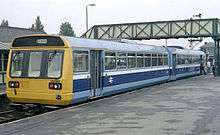
From new, some units were painted according to the region they operated in. For example, the first 14 Greater Manchester Passenger Transport Executive sponsored units (142001-014) received GMPTE orange and brown, then the next 13 West Country based units (142015-027) were painted in a Great Western Railway inspired chocolate and cream livery and marketed as 'Skippers'.[17]
Post privatisation
Northern England
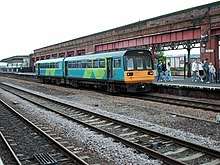
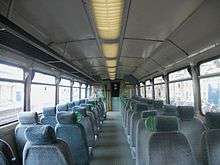
Upon the privatisation of British Rail, the Class 142 Fleet was divided between North Western Trains in the North West and Northern Spirit in the North East.
Northern Spirit started its operations in 1997 and continued until 2000. At this point, parent company MTL ran into difficulties and the company was sold to Arriva, who renamed it as Arriva Trains Northern.
In 1998 ATN swapped seven Class 142s (142085-142091) for seven Class 150/2 units from Valley Lines.[18] In October–December 2002 these were swapped for unrefurbished units 142072-77 and 080–3, as 142086-091 had only recently been refurbished by Northern Spirit and Valley Lines wished to start their refurbishment from scratch.
In 2004 First North Western and Arriva Trains Northern was merged into the Northern rail franchise, which inherited a combined fleet of 79 Class 142s.
All 79 Class 142s are now painted in Northern Rail livery. Due to rising passenger numbers in the north of England (by about 10% per annum and even by over 25% per annum at some stations where 142s are in operation),[11] some units have been replaced by Sprinter trains.[19]
Five Class 142 Pacers, in service with First Great Western, were returned to Northern Rail in December 2008; the rest returned to Northern Rail by November 2011, much later than originally planned.
Despite being built for branch-line stopping services, the Class 142s are mainly used on urban commuter services in and out of cities like Liverpool, Manchester, Sheffield, Leeds and Newcastle and can be seen on longer-distance services of up to three hours including the 1632 Middlesbrough-Carlisle service (nearly 110 miles); they had also been used on services between Blackpool North and Chester via Stockport, which ceased to operate in December 2008. All 79 passed with the Northern franchise to Arriva Rail North in April 2016, and any remaining units transferred to the government-owned operator Northern Trains on 1 March 2020.
Merseyside
A total of seventeen Class 142 units based at Newton Heath TMD (142041-049 and 142051-058) were refurbished for use on Merseyside Passenger Transport Executive's City Line on services around the Liverpool and Greater Manchester areas.[20] The refurbishment included dot-matrix route indicators, a new design of individual low-backed seating and the units were repainted into Merseyrail's livery. Upon privatisation, these units passed to First North Western in March 1997. All of these sets transferred to Northern in 2016, however remained in the livery of previous operator Northern Rail.
Wales
Valley Lines acquired its Class 142s by swapping Class 150/2 units with Arriva Trains Northern. The Class 142s were initially painted in Valley Lines livery.
Transport for Wales uses its Class 142 Pacer trains on the commuter lines around Cardiff, Barry and Penarth known as the Valley lines. All of its Class 142 Pacer fleet now bear the turquoise and cream house colours of Arriva Trains Wales.
The Class 142s are frequently used for the Cardiff to Penarth service calling at Grangetown, Dingle Road, and Penarth.
The Class 142 units are also primarily used on South Wales Valley line routes and routes through the Vale of Glamorgan. On Valley and Vale of Glamorgan services, Class 142s are often coupled together with Class 143 or Class 150 units to cope with demand on the busy Valley Lines network. The Class 142s have received minor refurbishments with retrimmed seats in new moquette, plus the installation of ceiling-mounted CCTV cameras.
South West England
Twelve Class 142 Pacers were received by First Great Western in 2007, and started operations in December 2007. These were loaned from Northern (where they had been stored), in part to cover for the refurbishment of FGW's Sprinter fleets but also to allow the Class 158s to be reformed as three-coach sets.
The 142s were based at Exeter TMD, working alongside the similar Class 143s on services in Devon and Cornwall, including the Avocet Line, Riviera Line and Tarka Line.
Five 142s were returned to Northern Rail in the autumn of 2008, following the completion of the refresh of Class 150 Sprinter units. The remaining seven units were returned to Northern Rail in November 2011 after being replaced by class 150 units cascaded from London Overground and London Midland.
Withdrawal
All 94 Class 142s will be withdrawn by mid-2020, as they do not comply with the Persons with Reduced Mobility Technical Specification for Interoperability (PRM-TSI).[21][22]
Bidders for the Northern franchise that commenced in April 2016 were required to order new DMUs and take on Sprinters and Turbostars (Classes 150, 156, 158 and 170) released by other franchises as replacement.[23] The Long Term Passenger Rolling Stock Strategy for the Rail Industry indicates up to 500 non-electric carriages will need to be built in the short term.[24] Northern withdrawals were scheduled to commence in November 2018 with the last to be removed from traffic in October 2019.[25] This has been slightly delayed until the first Class 195s enter service.
Wales & Borders franchise holder KeolisAmey Wales will replace all of its Class 142s by mid-2020.[26]
In August 2019, Northern retired seven and placed them in store at Heaton TMD.[27][28] Scrapping commenced in December 2019 with 142005 taken to CF Booth, Rotherham.[29] In December 2019, three withdrawn Northern units were transferred to Transport for Wales for spare parts.[30]
In December 2019, both Northern and Transport for Wales were issued derogations to allow use into 2020. Northern Trains are permitted to the use the units until the 31 May 2020, but only whilst coupled to a compliant unit,[31] whilst Transport for Wales are permitted to use the units until 31 July 2020 and can be operated alone.[32]
Preservation
Seventeen class 142 units have so far been saved/earmarked for preservation. The majority all being ex-Northern operated units. Unit no 142001 is part of the National Collection and preserved at the National Railway Museum Shildon.[33] Additionally, three further units are to be preserved. Unit 142003 is to be purchased by a private individual, two further units 142023 and 142036 are to also be preserved following withdrawal from service in May 2020. 142023 will be based at the Plym Valley Railway and 142036 at the East Kent Railway.
A further few units are also preserved on the Chasewater Railway, the Wensleydale Railway and Whitrope Heritage Centre each.
Operational
| Set number | Vehicle numbers | Livery | Location | Notes | |
|---|---|---|---|---|---|
| DMS | DMSL | ||||
| 142001 | 55542 | 55592 | Northern Rail unbranded | National Railway Museum Shildon | Operational[34] First unit built. To be repainted into GMPTE orange livery. |
| 142003 | 55544 | 55594 | Northern Rail unbranded | Purchased by a private individual. Current fate unknown. | |
| 142004 | 55545 | 55595 | Northern Rail unbranded | Purchased by a private individual. Current fate unknown. To be repainted into GMPTE orange livery. | |
| 142017 | 55558 | 55608 | Northern Rail unbranded | East Kent Railway | |
| 142019 | 55560 | 55610 | Northern Rail unbranded | Waverley Route Heritage Association | |
| 142020 | 55561 | 55611 | Northern Rail unbranded | Waverley Route Heritage Association | |
| 142023 | 55565 | 55614 | Northern Rail | Plym Valley Railway | |
| 142028 | 55569 | 55619 | Northern Rail unbranded | Wensleydale Railway | |
| 142029 | 55570 | 55620 | Northern Rail unbranded | Chasewater Railway[35] | |
| 142030 | 55571 | 55621 | Northern Rail unbranded | Chasewater Railway | |
| 142035 | 55576 | 55626 | Northern Rail | Wensleydale Railway | [36] |
| 142036 | 55577 | 55627 | Northern Rail | East Kent Railway | |
| 142038 | 55579 | 55629 | Northern Rail unbranded | Mid-Norfolk Railway | Purchased by a private individual and later donated to the Mid-Norfolk Railway. To be repainted into BR Provincial blue. |
| 142041 | 55582 | 55632 | Northern Rail unbranded | Wensleydale Railway | [36] |
| 142055 | 55596 | 55646 | Northern Rail unbranded | Foxfield Railway | purchased by the Pacer Rail Group and based at the Foxfield Railway |
| 142084 | 55734 | 55780 | Northern Rail unbranded | Rushden Historical Transport Society | To be repainted into Regional Railways livery. |
| 142091 | 55741 | 55787 | Northern Rail unbranded | Rushden Historical Transport Society | To be repainted into Regional Railways livery. |
142027 was purchased as a spares donor for the Chasewater Railway's two operational Class 142 units (142029 and 142030).
Non-railway use
Alongside the operational preserved class 142s, one has already been acquired by South Wales Police.
| Set number | Vehicle numbers | Location | Notes | |
|---|---|---|---|---|
| DMS | DMSL | |||
| 142033 | 55574 | 55624 | Brewery Field, Bridgend | Acquired by South Wales Police for training. Located at Bridgend rugby pitch. |
| 142060 | 55710 | 55756 | Wensleydale Railway | To be converted to a holiday let and arts space[37] |
Liveries
 BR Western Region Class 142 No. 142025 at Newcastle
BR Western Region Class 142 No. 142025 at Newcastle BR/Manchester PTE Class 142 No. 142012 at Edale
BR/Manchester PTE Class 142 No. 142012 at Edale BR Provincial two-tone blue Class 142 No. 142061 at Preston
BR Provincial two-tone blue Class 142 No. 142061 at Preston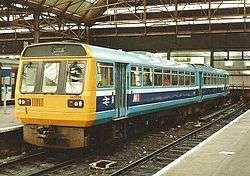 BR Provincial with added Network NorthWest branding
BR Provincial with added Network NorthWest branding
 Revised Greater Manchester PTE
Revised Greater Manchester PTE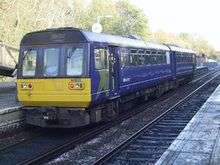 First North Western Class 142 No. 142031 at Hunts Cross
First North Western Class 142 No. 142031 at Hunts Cross- The interior of a refreshed First North Western Class 142
 First Great Western
First Great Western

 Arriva Trains Northern Class 142 No. 142094 at York
Arriva Trains Northern Class 142 No. 142094 at York Merseyrail Class 142 No. 142055 at Castleton East Junction
Merseyrail Class 142 No. 142055 at Castleton East Junction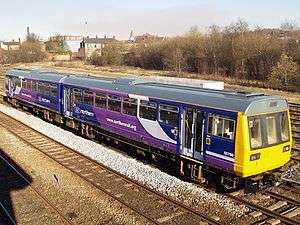 Northern Rail Class 142 No. 142084 at Castleton East Junction
Northern Rail Class 142 No. 142084 at Castleton East Junction
Fleet details
| Class | Operator | Numbers | Built | Cars per Set | Unit nos. |
|---|---|---|---|---|---|
| Class 142 | Transport for Wales | 15 | 1985–87 | 2 | 142002, 142006, 142010, 142069, 142072–077, 142080–083, 142085 |
| Stored | 31 | NT: 142003–142004[lower-alpha 1], 142007, 142011, 142013–014, 142018, 142023,[lower-alpha 1] 142032, 142035, 142041, 142043, 142045, 142047, 142051, 142056, 142058, 142061, 142065, 142068, 142070-071, 142078, 142087, 142089-090, 142094-095
TFW: 142012, 142079, 142086[lower-alpha 2] | |||
| Scrapped | 35 | 142005, 142008–009, 142015–016, 142021–022, 142024–026, 142031, 142034, 142037, 142039–040, 142042, 142044, 142046, 142048–050, 142052–054, 142057, 142059, 142062–064, 142066–067, 142088, 142092–093, 142096 | |||
| Preserved | 15 | 142001, 142017, 142019–020, 142027,[lower-alpha 3] 142028–030, 142033[lower-alpha 4], 142036, 142038, 142055, 142060, 142084, 142091 |
- earmarked for preservation
- These units are being used by Transport for Wales for spare parts prior to being scrapped.
- Currently at Chasewater Railway as a source of spares only
- 142033 is being used by South Wales Police as a training unit.
Named units
Select units have previously carried names.
- 142009 – Newton Heath 125 1876–2001 (denamed)[38]
- 142073 – Myfanwy (denamed)
- 142080 – Caerphilly RFC (denamed)[39]
| Year | Quantity in service at start of year | Quantity withdrawn | Numbers | Notes |
|---|---|---|---|---|
| 1991 | 96 | 1 | 142059 | |
| 1999 | 95 | 1 | 142008 | |
| 2019 | 94 | 44 | 142001/03/05/07/09/12/15-17/19-22/25-27/29-31/33-34/37-39/42/44/46/48-50/52-53/57/60/64/66/79/84/86/88/91-93/96 | 142001, 003, 017, 019, 020, 029, 030, 033, 038, 060, 084 & 091 preserved |
| 2020 | 50 | 50 | 142002/04/06/10-11/13-14/18/23-24/28/32/35-36/40-41/43/45/47/51/54-56/58/61-63/65/67-78/80-83/85/87/89-90/94-95 | 142004, 023, 028 & 036 preserved |
Accidents
- Two Class 142 units have been withdrawn through accident damage. The first of which was unit 142059, which was withdrawn in 1991 after colliding with a buffer stop at Liverpool Lime Street. The train had run away down the hill from Edge Hill whilst returning with brake problems. The train was running without passengers at the time and the driver and guard both survived the accident without serious lasting injury. The platforms were evacuated in time before the train struck the buffers.[40]
- The most serious accident involving a Class 142 was at Winsford in 1999.[41] The driver of Class 142 No. 142008 operated by First North Western, running empty from Crewe to Liverpool Lime Street overran a red signal on the slow line and stopped in the path of the 06:15 London Euston to Glasgow Central Virgin Trains express, hauled by a Class 87 electric locomotive, No. 87027 Wolf of Badenoch.[42] The impact, which caused the unit to be written off, severed the Pacer's body from its frames and caused severe internal damage. This raised concerns over the crashworthiness of the design.[43][44]
- On 11 June 2009, a Class 142 (No. 142042) operated by Northern Rail derailed while en route from Blackpool to Liverpool. All but one of the 40 passengers on board escaped injury. An initial investigation was carried out by the UK Rail Accident Investigation Branch which determined that the engine mounted under the rear coach became detached and fell onto the track at a recorded speed of 57 mph, derailing the rear axle. The detachment of the engine caused extensive damage to underfloor equipment, severing control wires and damaging the braking system resulting in an automatic emergency brake application. The engine became detached following the failure of its attachment to the flywheel housing. Two of the three engine mounting points are on the flywheel housing which remained attached to the vehicle. Engine parts were recovered and taken to the engine overhauler's workshops for supervised examination and dismantling. The bearings and other internal engine parts were found to be in order with no signs of overheating or seizure. The engine crankshaft had broken between the big end bearing of the sixth cylinder and the main bearing in the engine casing at the flywheel end. This break exhibited marks characteristic of a fatigue failure. The torque load on the crankshaft of an engine on full power is at its maximum between the last cylinder and the flywheel, the location of the fracture. A piece of the main bearing and its fixing bolt were the first items found in the debris trail towards the derailed train at 453m back from where the train stopped. The engine block was 205m back from the stopped train. The track was damaged over a distance of 330m. The engine had been overhauled and was fitted to 142042 in March 2008. The crankshaft had been used in two other engines before being fitted to this engine. It had been reground and subjected to magnetic particle inspection (MPI) to check for flaws before it was fitted to this engine. The unit had covered 114,577 miles since returning to service. The rebuilt engines were given an interval of 400,000 miles between overhauls. Subsequently, newer more sensitive MPI equipment was introduced by the engine overhaulers.[45] Problems with engines on 142s have been experienced before.[46]
- On 8 August 2009, Arriva Trains Wales unit 142069 derailed during an empty stock movement at Rhymney, South Wales. The unit was preparing to work a morning service with 143625 when it derailed on a set of points and hit the platform edge. 142069 was later removed by road to Cardiff Canton depot and fears were raised that the frame might have been damaged beyond repair. These fears proved unfounded and the unit has since returned to service.
- On 3 October 2009, a unit of the class collided with another train at Darlington.[47]
- On 4 January 2010, unit 142029 collided with a train comprising two Class 159 diesel multiple units at Exeter St Davids. Nine people were injured.[48]
- On 10 April 2011, a cardan shaft failure on 142045 led to an incident at Durham, injuring a member of the public with a piece of ballast kicked up by the detached shaft.[49]
- On 27 April 2012, unit 142091 was working the 1125 Lincoln – Adwick service when it hit a landslide after exiting Clarborough Tunnel near Retford causing major frontal damage to the unit. Two people were taken to hospital with minor injuries, one of these being the driver.[50][51] The landslide was blamed on heavy rain and poor drainage.[51] The unit has since returned to service.
- On 4 October 2016, unit 142072 caught fire at Caerphilly.[52]
- On 9 October 2018, unit 142086 derailed at Sheffield station.[53][54][55]
John Pugh, the then Liberal Democrat MP for Southport, described the 142 trains as "unsafe". However the UK Government's Transport Secretary at the time Geoff Hoon denied this claim saying, "I would not accept that any of that rolling stock is unsafe", and that they constantly upgrade them.[56][57]
Models
In 1987, Hornby Railways launched its first version of the BR Class 142 (Pacer) railbus in OO gauge.[58]
Notes
References
Citations
- Fox & Hughes 1994, pp. 15–16, 25
- Colin J Marsden. "Class 142 Technical Data". therailwaycentre.com. Archived from the original on 20 March 2012. Retrieved 24 March 2010.
- "Class 142". The Railway Centre. Archived from the original on 9 March 2005. Retrieved 1 February 2016.
- Vehicle Diagram Book No. 220 for Diesel Multiple Unit Trains (Railcars) (PDF). Barrowmore MRG. Derby: British Railways Board. 1982. DP234, DP235.
- "Passenger Focus response to Network Rail's North West Route Utilisation Strategy" (PDF). Network Rail. January 2007. Archived from the original (PDF) on 3 March 2016. Retrieved 2 December 2015.
- "The Northern Interim Franchise Agreement" (PDF). Bevan Brittan LLP. 26 March 2014. Retrieved 22 April 2015.
- Fox 1987, p. 41
- Pritchard & Fox 2009, p. 15
- "Mechanical and Electrical Coupling Index". Rail Safety and Standards Board. Archived from the original on 21 December 2013. Retrieved 13 October 2010.
- "Diesel Multiple Unit Stock". Goods & Not So Goods. Archived from the original on 4 March 2016. Retrieved 2 December 2015.
- "Mid Cheshire Rail Users Association" (PDF). Network Rail. Archived from the original (PDF) on 16 January 2016. Retrieved 2 December 2015.
- "142 – BREL/Leyland Pacer". Data Sheets. Angel Trains. Retrieved 8 July 2008.
- http://www.ttweb.co.uk/pp/pp142.pdf
- Glendinning, Alec (26 March 2014). "The Network Rail (Ordsall Chord) Order" (PDF). Network Rail. p. 11. Archived from the original (PDF) on 22 December 2016. Retrieved 18 February 2016.
- https://www.angeltrains.co.uk/Products-Services/Regional-Passenger-Trains/1
- "Passengers stranded by derailment". BBC News. 12 June 2009. Retrieved 2 December 2015.
- "Cornish Capers".
- "Northern Spirit and Cardiff swap DMUs" Rail (magazine) issue 340 23 September 1998 page 9
- "More trains for busy routes" (PDF). Railwatch. Railfuture. July 2007. p. 3. Archived from the original (PDF) on 17 January 2016. Retrieved 2 December 2015.
- "Pacer Page 1- Class 142". pacerchaser. Retrieved 25 April 2015.
- Clinnick, Richard (1 May 2013). "Angel Trains to withdraw all its Class 142 Pacers by 2020". Rail. 721. Peterborough. p. 11.
- 142s to be retained into 2020 Rail Express issue 283 December 2019 page 13
- "Northern Invitation to Tender" (PDF). Department for Transport. Retrieved 2 December 2015.
- "More rolling stock needed as passenger growth rises again". Railnews. 9 March 2015. Retrieved 2 December 2015.
- "Northern announces dates for rundown of Pacer fleet" Rail Express issue 244 September 2016 page 11
- Electrification and train-trams in ambitious Wales franchise Railway Gazette International 6 June 2018
- "Northern retires first Pacer train". Northern. Northern. Retrieved 13 August 2019.
- Clinnick, Richard. "First seven Pacers to be withdrawn by Northern this weekend". Rail Magazine. Rail Magazine. Retrieved 13 August 2019.
- "First Northern Pacer taken for scrapping, with dozens to follow". RAIL. 5 December 2019. Retrieved 27 December 2019.
- Northern Pacers stored and ready for scrapping Rail issue 895 2 January 2020 page 18
- Wilkinson, Peter (4 December 2019). "The Railways (Interoperability) Regulations 2011 – Northern Class 142 - 2020 accessibility deadline" (PDF). DfT. Archived (PDF) from the original on 1 January 2020. Retrieved 1 January 2020.
- Wilkinson, Peter (4 December 2019). "The Railways (Interoperability) Regulations 2011 – Transport for Wales Rail Services Class 142s - 2020 accessibility deadline" (PDF). DfT. Archived (PDF) from the original on 1 January 2020. Retrieved 1 January 2020.
- Pioneer Class 142 claimed for National Collection Rail Express issue 268 September 2018 page 76
- First Pacer train goes into Locomotion museum at Shildon The Northern Echo 19 December 2019
- "Two of Northern's Pacer trains are going to this heritage railway to be preserved". Yorkshire Post. 23 December 2019. Retrieved 27 December 2019.
- "Northern Trains Class 142 Pacer Withdrawls & Scrapping". Rail Record. Retrieved 5 June 2020.
- "Meet the young couple who saved two Pacers from scrap - and want to live in one". Yorkshire Post. 4 April 2020. Retrieved 1 May 2020.
- "Class 142".
- "Class 142 – Matty P's Railway Pics". Mattypsrailwaypics.com. Retrieved 28 November 2018.
- https://www.urbanghostsmedia.com/2017/04/crashed-pacer-142059-manchester-victoria/
- "Report by the Health and Safety Executive's Railway Inspectorate into the train accident at Winsford South Junction on 23 June 1999" (PDF). Retrieved 28 November 2018.
- "Train driver averts disaster". BBC News. 23 June 1999. Retrieved 2 December 2015.
A train driver has prevented a major disaster by braking seconds before his express ploughed into another train.
-
"Safety fears over commuter trains". BBC News. 2 July 1999. Retrieved 4 July 2008.
The railway inspectors say lightweight rail-bus trains do not meet current safety standards and they are concerned that some of them are now being used on the same tracks as conventional heavyweight inter-city and freight trains.
- "Far-reaching implications for Pacer safety". Railway Magazine. May 2000. p. 18.
- "RAIB Bulletin 09/2009" (PDF). Rail Accident Investigation Branch. Retrieved 2 December 2015.
- Anderson, Vicky (12 June 2009). "Dozens flee derailed train in Liverpool". Liverpool Echo. Archived from the original on 19 March 2012.
- "Passenger train collision at Darlington 3 October 2009" (PDF). Rail Accident Investigation Branch. Retrieved 31 July 2018.
- "Report 10/2010 Collision at Exeter St Davids station 4 January 2010" (PDF). Rail Accidents Investigation Branch. Retrieved 13 February 2010.
- "Detachment of a cardan shaft at Durham station 10 April 2011" (PDF). Rail Accident Investigation Board. Retrieved 31 July 2018.
- "Landslide derails Northern Rail passenger train in Clarborough". BBC News. 27 April 2012. Retrieved 13 August 2012.
- "Nottinghamshire train derailment prompts national review". BBC News. 13 August 2012. Retrieved 13 August 2012.
- White, Bethany (4 October 2016). "These shocking pictures show the moment a fire caused a train to fill with smoke while passengers were on board". Walesonline. Media Wales Ltd. Retrieved 5 October 2016.
- "Updates as train derails outside Sheffield station". Rail Advent.
- "Disruption to services after train derails at Sheffield station". Derbyshire Times. Retrieved 8 July 2019.
- "Investigation launched following derailment of Sheffield train". The Star. Retrieved 8 July 2019.
- "MP says trains in area are 'unsafe'". Lancashire Evening Post. Preston. 17 February 2009. Retrieved 2 December 2015.
- Siddle, John (2 January 2009). "Northern Rail, which runs the Southport to Manchester line, told to improve its services after announcing ticket price hikes". Southport Visiter. Archived from the original on 16 July 2011. Retrieved 2 December 2015.
- "Hornby - BR Class 142 Railbus 1987". Hornby Railways Collector Guide. Retrieved 2 February 2020.
Bibliography
- Fox, Peter (1987). Multiple Unit Pocket Book. British Railways Pocket Book No.2 (Summer/Autumn 1987 ed.). Platform 5 Publishing Ltd. ISBN 0906579740. OCLC 613347580.CS1 maint: ref=harv (link)
- Fox, Peter; Hughes, Barry (1994). DMUs & Channel Tunnel Stock. British Railways Pocket Book No.3 (7th ed.). Platform 5. ISBN 9781872524597.CS1 maint: ref=harv (link)
- Pritchard, R.N.; Fox, Peter (2009). Diesel Multiple Units 2010. British Railways Pocket Book No.3. Platform 5. ISBN 978-1-902336-75-6. OCLC 614300319.CS1 maint: ref=harv (link)
External links
![]()